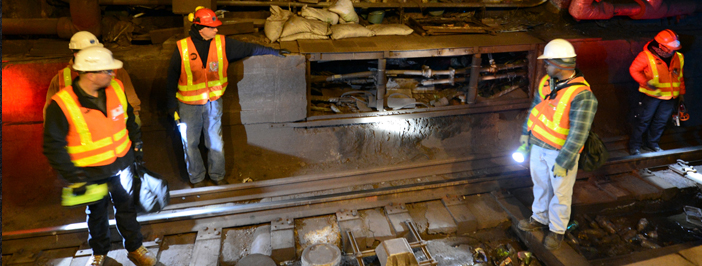If you show up late to the 20th annual Brooklyn Reality Tour — the famous FlyerTalk tour will actually be in its 19th year in 2019 due to an inexplicably severe case of triskaidekaphobia three years ago — and that mean old Dan Hammer leaves you behind and went ahead with the tour anyway, chances are that one transportation option to catch up to his tour will not be available to you.
Subway Tunnel Slated to Be Closed for 18 Months in New York
This official statement — which was issued by the New York City Transit division of the Metropolitan Transportation Authority — revealed that massive reconstruction work needed to the Canarsie Tunnel will require a full closure of the tunnel for 18 months starting no sooner than 2019. Service in Manhattan will be suspended during the entire length of the closure of the Canarsie Tunnel; while service in Brooklyn is expected to remain relatively normal.
Several alternative options are being considered for passengers of the L line — including but not limited to increased and enhanced bus service; possible ferry service across the East River; ride share options; bicycle sharing options; and bolstering train service along lines such as the G, J and M.
The Canarsie Tunnel carries trains of the L line under the East River between Brooklyn and Manhattan; and the trains pass under neighborhoods such as Williamsburg which have experienced gentrification and a resurgence in popularity in recent years — resulting in the L line to grow over the past decade into one of the busiest subway lines in New York, as it is used by greater than 225,000 commuters every weekday. Ridership on the L line has more than tripled since 1990, which has resulted in it becoming the tenth largest subway in North America; and use of the Bedford Avenue subway station alone has quintupled, according to this article from the Metropolitan Transportation Authority. “This growth has fueled unprecedented revitalization of housing and business development in several neighborhoods along the line.”
The damage to the Canarsie Tunnel has been described as “catastrophic”, superseded in magnitude only by the destruction to the subway system underneath the former World Trade Center as a result of the terrorist attacks which occurred on Tuesday, September 11, 2001 — and a complete reconstruction of the tunnel is the only way to assure safety for subway passengers who use it.
Included in that article is this video pertaining to reconstruction of the Canarsie Tunnel, which first opened to the public 92 years ago in 1924.
The Canarsie Tunnel — named for the neighborhood in Brooklyn which serves as the eastern terminus for the L line — was substantially damaged with approximately seven million gallons of salt water caused from flooding by Hurricane Sandy back on Monday, October 29, 2012, which I covered extensively through these articles:
- Hurricane Sandy Threatens Eastern United States and Canada
- Northeastern United States and Canada Brace for Hurricane Sandy; Airlines Issue Advisories and Alerts for Historic Storm
- Power Outages Possible in 22 States and Six Provinces From Hurricane Sandy; FlyerTalk Discussion Update
- FlyerTalk Members Report Effects of Hurricane Sandy, Major Storm; FlyerTalk Discussion List Update
- Sandy Absorbed by Winter Storm; Airports Closed; Millions Without Power in 11 States; Flood Warnings
- Travel Alert: New Storm Approaching; 2.0 Magnitude Earthquake Strikes Areas of New Jersey Affected by Sandy
- My Thoughts on Sandy — and How You Can Help Storm Victims
Summary
As a former passenger of the L line, I have been through the Canarsie Tunnel literally hundreds of times over the course of nine years.
The L line is the only major subway line in New York which does not share a track with any other subway line; and it has always been a local line with no express train service — except in unusual situations — so alternative options are not as easy as they would be for most of the other subway lines. The L line used to be the proverbial stepchild of the subway system before its significant increase in popularity and its receiving the latest in technology pertaining to the trains which run on it.
That the Metropolitan Transportation Authority is being proactive about the future of the Canarsie Tunnel is good for riders of the L line; and hopefully it will lead to further improved service in the future…
…but if you plan on traveling to or within New York in 2019 through 2021 and want to use the L line as a passenger — such as embarking on the aforementioned Brooklyn Reality Tour by Dan Hammer, who is also known as FlyerTalk member dhammer53 and really is not all that mean and old after all — ensure that you keep yourself updated with the latest information pertaining to the reconstruction of the Canarsie Tunnel.
